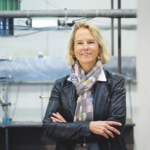Unique
With ACTIVE SITES, the UDE is getting a new research building where big things will happen. It is a place where scientists will use new combinations of methods to study tiny molecular processes of active sites in a natural environment. That is top international research. By Thomas Wittek
ACTIVE SITES – the name says it all: This is a building dedicated to the study of so-called active sites. They play an important role in chemical and biological processes, for instance in energy conversion, water purification, or the development of active agents.
Both the Science Council and the Joint Science Conference (GWK) of the federal and state governments have recently given the green light for financing the construction of the building, which will be located on the Essen campus and provide 4,800 m² of total usable space. The costs of 70 million euros will be shared by the federal government, the State of North Rhine-Westphalia, and the University. ACTIVE SITES represents a milestone for fundamental research at the UDE.
‘The Science Council had already assessed the plans for the new research building as “outstanding”,’ says Rector Prof. Dr. Barbara Albert. ‘The GWK’s final decision in favour of funding is a great success and confirms that we are on the right track.’
The goal of the project is to develop new large instrument-based methods that use knowledge from different disciplines to study active sites. Active sites are understood as binding and reaction sites for molecules. The challenge is to observe the sequence of reactions live and in their natural environment: ‘Up to now, active sites have mostly been analysed either in an artificial environment or only indirectly through comparison before and after the reaction,’ explains the technical chemist and deputy spokesperson of ACTIVE SITES, Prof. Dr. Corina Andronescu. ‘We want to make the reactions visible in a natural aqueous environment. To do so, we will develop a set of methods that brings together and combines the expertise of the various fields of chemistry, biology, physics and engineering. This approach of working across disciplines as well as across substances is unprecedented.’
The knowledge thus gained can be used to influence reactions and steer them in desired directions. For example, the basic research could help in the search for answers to pressing questions of our time, such as how to unravel the nature of individual cells in the ecosystem or even of global biogeochemical cycles. Many industrial processes also stand to benefit from the new set of methods: In comparatively mild catalysis in water, processes such as CO2 reduction or hydrogen production could be improved.
The layout of the new building will reflect the interdisciplinary approach. The plans provide for many open workspaces and joint laboratories. They are intended to stimulate exchange and can be flexibly adapted to the requirements of different research groups. The building will be constructed on the ‘Am Thurmfeld’ site, where the FutureWaterCampus will also find its home. Groundbreaking is planned for 2023, and the first researchers are set to move in by 2026.



